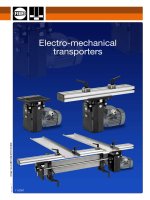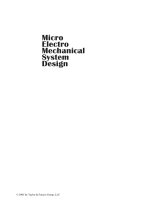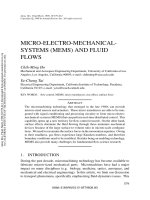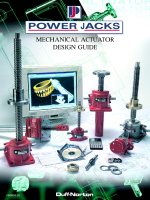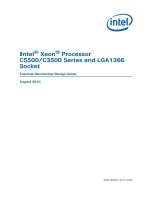Micro Electro Mechanical System Design© 2005 potx
Bạn đang xem bản rút gọn của tài liệu. Xem và tải ngay bản đầy đủ của tài liệu tại đây (17.98 MB, 463 trang )
Micro
Electro
Mechanical
System
Design
© 2005 by Taylor & Francis Group, LLC
MECHANICAL ENGINEERING
A Series of Textbooks and Reference Books
Founding Editor
L. L. Faulkner
Columbus Division, Battelle Memorial Institute
and Department of Mechanical Engineering
The Ohio State University
Columbus, Ohio
1.
2.
3.
4.
5.
6.
7.
8.
9.
10.
11.
12.
13.
14.
15.
16.
17.
18.
19.
20.
21.
22.
23.
24.
Spring Designer’s Handbook, Harold Carlson
Computer-Aided Graphics and Design, Daniel L. Ryan
Lubrication Fundamentals, J. George Wills
Solar Engineering for Domestic Buildings, William A. Himmelman
Applied Engineering Mechanics: Statics and Dynamics, G. Boothroyd
and C. Poli
Centrifugal Pump Clinic, Igor J. Karassik
Computer-Aided Kinetics for Machine Design, Daniel L. Ryan
Plastics Products Design Handbook, Part A: Materials and Components;
Part B: Processes and Design for Processes, edited by Edward Miller
Turbomachinery: Basic Theory and Applications, Earl Logan, Jr.
Vibrations of Shells and Plates, Werner Soedel
Flat and Corrugated Diaphragm Design Handbook, Mario Di Giovanni
Practical Stress Analysis in Engineering Design, Alexander Blake
An Introduction to the Design and Behavior of Bolted Joints,
John H. Bickford
Optimal Engineering Design: Principles and Applications, James N. Siddall
Spring Manufacturing Handbook, Harold Carlson
Industrial Noise Control: Fundamentals and Applications, edited by
Lewis H. Bell
Gears and Their Vibration: A Basic Approach to Understanding Gear Noise,
J. Derek Smith
Chains for Power Transmission and Material Handling: Design
and Applications Handbook, American Chain Association
Corrosion and Corrosion Protection Handbook, edited by
Philip A. Schweitzer
Gear Drive Systems: Design and Application, Peter Lynwander
Controlling In-Plant Airborne Contaminants: Systems Design
and Calculations, John D. Constance
CAD/CAM Systems Planning and Implementation, Charles S. Knox
Probabilistic Engineering Design: Principles and Applications,
James N. Siddall
Traction Drives: Selection and Application, Frederick W. Heilich III
and Eugene E. Shube
© 2005 by Taylor & Francis Group, LLC
25.
26.
27.
28.
29.
30.
31.
32.
33.
34.
35.
36.
37.
38.
39.
40.
41.
42.
43.
44.
45.
46.
47.
48.
49.
50.
51.
52.
53.
54.
55.
56.
Finite Element Methods: An Introduction, Ronald L. Huston
and Chris E. Passerello
Mechanical Fastening of Plastics: An Engineering Handbook,
Brayton Lincoln, Kenneth J. Gomes, and James F. Braden
Lubrication in Practice: Second Edition, edited by W. S. Robertson
Principles of Automated Drafting, Daniel L. Ryan
Practical Seal Design, edited by Leonard J. Martini
Engineering Documentation for CAD/CAM Applications, Charles S. Knox
Design Dimensioning with Computer Graphics Applications,
Jerome C. Lange
Mechanism Analysis: Simplified Graphical and Analytical Techniques,
Lyndon O. Barton
CAD/CAM Systems: Justification, Implementation, Productivity
Measurement, Edward J. Preston, George W. Crawford,
and Mark E. Coticchia
Steam Plant Calculations Manual, V. Ganapathy
Design Assurance for Engineers and Managers, John A. Burgess
Heat Transfer Fluids and Systems for Process and Energy Applications,
Jasbir Singh
Potential Flows: Computer Graphic Solutions, Robert H. Kirchhoff
Computer-Aided Graphics and Design: Second Edition, Daniel L. Ryan
Electronically Controlled Proportional Valves: Selection and Application,
Michael J. Tonyan, edited by Tobi Goldoftas
Pressure Gauge Handbook, AMETEK, U.S. Gauge Division,
edited by Philip W. Harland
Fabric Filtration for Combustion Sources: Fundamentals and Basic
Technology, R. P. Donovan
Design of Mechanical Joints, Alexander Blake
CAD/CAM Dictionary, Edward J. Preston, George W. Crawford,
and Mark E. Coticchia
Machinery Adhesives for Locking, Retaining, and Sealing, Girard S. Haviland
Couplings and Joints: Design, Selection, and Application, Jon R. Mancuso
Shaft Alignment Handbook, John Piotrowski
BASIC Programs for Steam Plant Engineers: Boilers, Combustion,
Fluid Flow, and Heat Transfer, V. Ganapathy
Solving Mechanical Design Problems with Computer Graphics,
Jerome C. Lange
Plastics Gearing: Selection and Application, Clifford E. Adams
Clutches and Brakes: Design and Selection, William C. Orthwein
Transducers in Mechanical and Electronic Design, Harry L. Trietley
Metallurgical Applications of Shock-Wave and High-Strain-Rate Phenomena,
edited by Lawrence E. Murr, Karl P. Staudhammer, and Marc A. Meyers
Magnesium Products Design, Robert S. Busk
How to Integrate CAD/CAM Systems: Management and Technology,
William D. Engelke
Cam Design and Manufacture: Second Edition; with cam design software
for the IBM PC and compatibles, disk included, Preben W. Jensen
Solid-State AC Motor Controls: Selection and Application,
Sylvester Campbell
© 2005 by Taylor & Francis Group, LLC
57.
58.
59.
60.
61.
62.
63.
64.
65.
66.
67.
68.
69.
70.
71.
72.
73.
74.
75.
76.
77.
78.
79.
80.
81.
82.
83.
84.
85.
86.
87.
Fundamentals of Robotics, David D. Ardayfio
Belt Selection and Application for Engineers, edited by Wallace D. Erickson
Developing Three-Dimensional CAD Software with the IBM PC, C. Stan Wei
Organizing Data for CIM Applications, Charles S. Knox, with contributions
by Thomas C. Boos, Ross S. Culverhouse, and Paul F. Muchnicki
Computer-Aided Simulation in Railway Dynamics, by Rao V. Dukkipati
and Joseph R. Amyot
Fiber-Reinforced Composites: Materials, Manufacturing, and Design,
P. K. Mallick
Photoelectric Sensors and Controls: Selection and Application, Scott M. Juds
Finite Element Analysis with Personal Computers, Edward R. Champion, Jr.
and J. Michael Ensminger
Ultrasonics: Fundamentals, Technology, Applications: Second Edition,
Revised and Expanded, Dale Ensminger
Applied Finite Element Modeling: Practical Problem Solving for Engineers,
Jeffrey M. Steele
Measurement and Instrumentation in Engineering: Principles and Basic
Laboratory Experiments, Francis S. Tse and Ivan E. Morse
Centrifugal Pump Clinic: Second Edition, Revised and Expanded,
Igor J. Karassik
Practical Stress Analysis in Engineering Design: Second Edition,
Revised and Expanded, Alexander Blake
An Introduction to the Design and Behavior of Bolted Joints: Second Edition,
Revised and Expanded, John H. Bickford
High Vacuum Technology: A Practical Guide, Marsbed H. Hablanian
Pressure Sensors: Selection and Application, Duane Tandeske
Zinc Handbook: Properties, Processing, and Use in Design, Frank Porter
Thermal Fatigue of Metals, Andrzej Weronski and Tadeusz Hejwowski
Classical and Modern Mechanisms for Engineers and Inventors,
Preben W. Jensen
Handbook of Electronic Package Design, edited by Michael Pecht
Shock-Wave and High-Strain-Rate Phenomena in Materials, edited by
Marc A. Meyers, Lawrence E. Murr, and Karl P. Staudhammer
Industrial Refrigeration: Principles, Design and Applications, P. C. Koelet
Applied Combustion, Eugene L. Keating
Engine Oils and Automotive Lubrication, edited by Wilfried J. Bartz
Mechanism Analysis: Simplified and Graphical Techniques, Second Edition,
Revised and Expanded, Lyndon O. Barton
Fundamental Fluid Mechanics for the Practicing Engineer,
James W. Murdock
Fiber-Reinforced Composites: Materials, Manufacturing, and Design,
Second Edition, Revised and Expanded, P. K. Mallick
Numerical Methods for Engineering Applications, Edward R. Champion, Jr.
Turbomachinery: Basic Theory and Applications, Second Edition,
Revised and Expanded, Earl Logan, Jr.
Vibrations of Shells and Plates: Second Edition, Revised and Expanded,
Werner Soedel
Steam Plant Calculations Manual: Second Edition, Revised and Expanded,
V. Ganapathy
© 2005 by Taylor & Francis Group, LLC
88.
89.
90.
91.
92.
93.
94.
95.
96.
97.
98.
99.
100.
101.
102.
103.
104.
105.
106.
107.
108.
109.
110.
111.
112.
113.
114.
115.
116.
117.
118.
119.
Industrial Noise Control: Fundamentals and Applications, Second Edition,
Revised and Expanded, Lewis H. Bell and Douglas H. Bell
Finite Elements: Their Design and Performance, Richard H. MacNeal
Mechanical Properties of Polymers and Composites: Second Edition,
Revised and Expanded, Lawrence E. Nielsen and Robert F. Landel
Mechanical Wear Prediction and Prevention, Raymond G. Bayer
Mechanical Power Transmission Components, edited by David W. South
and Jon R. Mancuso
Handbook of Turbomachinery, edited by Earl Logan, Jr.
Engineering Documentation Control Practices and Procedures,
Ray E. Monahan
Refractory Linings Thermomechanical Design and Applications,
Charles A. Schacht
Geometric Dimensioning and Tolerancing: Applications and Techniques
for Use in Design, Manufacturing, and Inspection, James D. Meadows
An Introduction to the Design and Behavior of Bolted Joints: Third Edition,
Revised and Expanded, John H. Bickford
Shaft Alignment Handbook: Second Edition, Revised and Expanded,
John Piotrowski
Computer-Aided Design of Polymer-Matrix Composite Structures,
edited by Suong Van Hoa
Friction Science and Technology, Peter J. Blau
Introduction to Plastics and Composites: Mechanical Properties
and Engineering Applications, Edward Miller
Practical Fracture Mechanics in Design, Alexander Blake
Pump Characteristics and Applications, Michael W. Volk
Optical Principles and Technology for Engineers, James E. Stewart
Optimizing the Shape of Mechanical Elements and Structures, A. A. Seireg
and Jorge Rodriguez
Kinematics and Dynamics of Machinery, Vladimír Stejskal
and Michael Valásek
Shaft Seals for Dynamic Applications, Les Horve
Reliability-Based Mechanical Design, edited by Thomas A. Cruse
Mechanical Fastening, Joining, and Assembly, James A. Speck
Turbomachinery Fluid Dynamics and Heat Transfer, edited by Chunill Hah
High-Vacuum Technology: A Practical Guide, Second Edition,
Revised and Expanded, Marsbed H. Hablanian
Geometric Dimensioning and Tolerancing: Workbook and Answerbook,
James D. Meadows
Handbook of Materials Selection for Engineering Applications,
edited by G. T. Murray
Handbook of Thermoplastic Piping System Design, Thomas Sixsmith
and Reinhard Hanselka
Practical Guide to Finite Elements: A Solid Mechanics Approach,
Steven M. Lepi
Applied Computational Fluid Dynamics, edited by Vijay K. Garg
Fluid Sealing Technology, Heinz K. Muller and Bernard S. Nau
Friction and Lubrication in Mechanical Design, A. A. Seireg
Influence Functions and Matrices, Yuri A. Melnikov
© 2005 by Taylor & Francis Group, LLC
120.
121.
122.
123.
124.
125.
126.
127.
128.
129.
130.
131.
132.
133.
134.
135.
136.
137.
138.
139.
140.
141.
142.
143.
144.
145.
146.
147.
148.
149.
150.
Mechanical Analysis of Electronic Packaging Systems, Stephen A. McKeown
Couplings and Joints: Design, Selection, and Application, Second Edition,
Revised and Expanded, Jon R. Mancuso
Thermodynamics: Processes and Applications, Earl Logan, Jr.
Gear Noise and Vibration, J. Derek Smith
Practical Fluid Mechanics for Engineering Applications, John J. Bloomer
Handbook of Hydraulic Fluid Technology, edited by George E. Totten
Heat Exchanger Design Handbook, T. Kuppan
Designing for Product Sound Quality, Richard H. Lyon
Probability Applications in Mechanical Design, Franklin E. Fisher
and Joy R. Fisher
Nickel Alloys, edited by Ulrich Heubner
Rotating Machinery Vibration: Problem Analysis and Troubleshooting,
Maurice L. Adams, Jr.
Formulas for Dynamic Analysis, Ronald L. Huston and C. Q. Liu
Handbook of Machinery Dynamics, Lynn L. Faulkner and Earl Logan, Jr.
Rapid Prototyping Technology: Selection and Application,
Kenneth G. Cooper
Reciprocating Machinery Dynamics: Design and Analysis,
Abdulla S. Rangwala
Maintenance Excellence: Optimizing Equipment Life-Cycle Decisions,
edited by John D. Campbell and Andrew K. S. Jardine
Practical Guide to Industrial Boiler Systems, Ralph L. Vandagriff
Lubrication Fundamentals: Second Edition, Revised and Expanded,
D. M. Pirro and A. A. Wessol
Mechanical Life Cycle Handbook: Good Environmental Design
and Manufacturing, edited by Mahendra S. Hundal
Micromachining of Engineering Materials, edited by Joseph McGeough
Control Strategies for Dynamic Systems: Design and Implementation,
John H. Lumkes, Jr.
Practical Guide to Pressure Vessel Manufacturing, Sunil Pullarcot
Nondestructive Evaluation: Theory, Techniques, and Applications,
edited by Peter J. Shull
Diesel Engine Engineering: Thermodynamics, Dynamics, Design,
and Control, Andrei Makartchouk
Handbook of Machine Tool Analysis, Ioan D. Marinescu, Constantin Ispas,
and Dan Boboc
Implementing Concurrent Engineering in Small Companies,
Susan Carlson Skalak
Practical Guide to the Packaging of Electronics: Thermal and Mechanical
Design and Analysis, Ali Jamnia
Bearing Design in Machinery: Engineering Tribology and Lubrication,
Avraham Harnoy
Mechanical Reliability Improvement: Probability and Statistics
for Experimental Testing, R. E. Little
Industrial Boilers and Heat Recovery Steam Generators: Design,
Applications, and Calculations, V. Ganapathy
The CAD Guidebook: A Basic Manual for Understanding and Improving
Computer-Aided Design, Stephen J. Schoonmaker
© 2005 by Taylor & Francis Group, LLC
151.
152.
153.
154.
155.
156.
157.
158.
159.
160.
161.
162.
163.
164.
165.
166.
167.
168.
169.
170.
171.
172.
173.
174.
175.
176.
177.
178.
179.
180.
181.
Industrial Noise Control and Acoustics, Randall F. Barron
Mechanical Properties of Engineered Materials, Wolé Soboyejo
Reliability Verification, Testing, and Analysis in Engineering Design,
Gary S. Wasserman
Fundamental Mechanics of Fluids: Third Edition, I. G. Currie
Intermediate Heat Transfer, Kau-Fui Vincent Wong
HVAC Water Chillers and Cooling Towers: Fundamentals, Application,
and Operation, Herbert W. Stanford III
Gear Noise and Vibration: Second Edition, Revised and Expanded,
J. Derek Smith
Handbook of Turbomachinery: Second Edition, Revised and Expanded,
edited by Earl Logan, Jr. and Ramendra Roy
Piping and Pipeline Engineering: Design, Construction, Maintenance,
Integrity, and Repair, George A. Antaki
Turbomachinery: Design and Theory, Rama S. R. Gorla
and Aijaz Ahmed Khan
Target Costing: Market-Driven Product Design, M. Bradford Clifton,
Henry M. B. Bird, Robert E. Albano, and Wesley P. Townsend
Fluidized Bed Combustion, Simeon N. Oka
Theory of Dimensioning: An Introduction to Parameterizing Geometric
Models, Vijay Srinivasan
Handbook of Mechanical Alloy Design, edited by George E. Totten,
Lin Xie, and Kiyoshi Funatani
Structural Analysis of Polymeric Composite Materials, Mark E. Tuttle
Modeling and Simulation for Material Selection and Mechanical Design,
edited by George E. Totten, Lin Xie, and Kiyoshi Funatani
Handbook of Pneumatic Conveying Engineering, David Mills,
Mark G. Jones, and Vijay K. Agarwal
Clutches and Brakes: Design and Selection, Second Edition,
William C. Orthwein
Fundamentals of Fluid Film Lubrication: Second Edition,
Bernard J. Hamrock, Steven R. Schmid, and Bo O. Jacobson
Handbook of Lead-Free Solder Technology for Microelectronic
Assemblies, edited by Karl J. Puttlitz and Kathleen A. Stalter
Vehicle Stability, Dean Karnopp
Mechanical Wear Fundamentals and Testing: Second Edition,
Revised and Expanded, Raymond G. Bayer
Liquid Pipeline Hydraulics, E. Shashi Menon
Solid Fuels Combustion and Gasification, Marcio L. de Souza-Santos
Mechanical Tolerance Stackup and Analysis, Bryan R. Fischer
Engineering Design for Wear, Raymond G. Bayer
Vibrations of Shells and Plates: Third Edition, Revised and Expanded,
Werner Soedel
Refractories Handbook, edited by Charles A. Schacht
Practical Engineering Failure Analysis, Hani M. Tawancy,
Anwar Ul-Hamid, and Nureddin M. Abbas
Mechanical Alloying and Milling, C. Suryanarayana
Mechanical Vibration: Analysis, Uncertainties, and Control,
Second Edition, Revised and Expanded, Haym Benaroya
© 2005 by Taylor & Francis Group, LLC
182.
183.
184.
185.
186.
187.
188.
189.
190.
191.
192.
193.
194.
Design of Automatic Machinery, Stephen J. Derby
Practical Fracture Mechanics in Design: Second Edition, Revised
and Expanded, Arun Shukla
Practical Guide to Designed Experiments, Paul D. Funkenbusch
Gigacycle Fatigue in Mechanical Practive, Claude Bathias
and Paul C. Paris
Selection of Engineering Materials and Adhesives, Lawrence W. Fisher
Boundary Methods: Elements, Contours, and Nodes, Subrata Mukherjee
and Yu Xie Mukherjee
Rotordynamics, Agnieszka (Agnes) Muszn
´yska
Pump Characteristics and Applications: Second Edition, Michael W. Volk
Reliability Engineering: Probability Models and Maintenance Methods,
Joel A. Nachlas
Industrial Heating: Principles, Techniques, Materials, Applications,
and Design, Yeshvant V. Deshmukh
Micro Electro Mechanical System Design, James J. Allen
Probability Models in Engineering and Science, Haym Benaroya
and Seon Han
Damage Mechanics, George Z. Voyiadjis and Peter I. Kattan
© 2005 by Taylor & Francis Group, LLC
Micro
Electro
Mechanical
System
Design
James J. Allen
Boca Raton London New York Singapore
A CRC title, part of the Taylor & Francis imprint, a member of the
Taylor & Francis Group, the academic division of T&F Informa plc.
© 2005 by Taylor & Francis Group, LLC
Published in 2005 by
CRC Press
Taylor & Francis Group
6000 Broken Sound Parkway NW, Suite 300
Boca Raton, FL 33487-2742
© 2005 by Taylor & Francis Group, LLC
CRC Press is an imprint of Taylor & Francis Group
No claim to original U.S. Government works
Printed in the United States of America on acid-free paper
10 9 8 7 6 5 4 3 2 1
International Standard Book Number-10: 0-8247-5824-2 (Hardcover)
International Standard Book Number-13: 978-0-8247-5824-0 (Hardcover)
Library of Congress Card Number 2005041771
This book contains information obtained from authentic and highly regarded sources. Reprinted material is
quoted with permission, and sources are indicated. A wide variety of references are listed. Reasonable efforts
have been made to publish reliable data and information, but the author and the publisher cannot assume
responsibility for the validity of all materials or for the consequences of their use.
No part of this book may be reprinted, reproduced, transmitted, or utilized in any form by any electronic,
mechanical, or other means, now known or hereafter invented, including photocopying, microfilming, and
recording, or in any information storage or retrieval system, without written permission from the publishers.
For permission to photocopy or use material electronically from this work, please access www.copyright.com
( or contact the Copyright Clearance Center, Inc. (CCC) 222 Rosewood Drive,
Danvers, MA 01923, 978-750-8400. CCC is a not-for-profit organization that provides licenses and registration
for a variety of users. For organizations that have been granted a photocopy license by the CCC, a separate
system of payment has been arranged.
Trademark Notice: Product or corporate names may be trademarks or registered trademarks, and are used only
for identification and explanation without intent to infringe.
Library of Congress Cataloging-in-Publication Data
Allen, James J.
Micro electro mechanical system design / James J. Allen.
p. cm. -- (Mechanical engineering ; 192)
Includes bibliographical references and index.
ISBN 0-8247-5824-2 (alk. paper)
1. Microelectromechanical systems--Design and construction. 2. Engineering design. I. Title. II.
Mechanical engineering (Taylor & Francis) ; 192.
TK153.A47 2005
621--dc22
2005041771
Visit the Taylor & Francis Web site at
Taylor & Francis Group
is the Academic Division of T&F Informa plc.
© 2005 by Taylor & Francis Group, LLC
and the CRC Press Web site at
Dedication
To Susan and Nathan
© 2005 by Taylor & Francis Group, LLC
Preface
This book attempts to provide an overview of the process of microelectromechanical
system (MEMS) design. In order to design a MEMS device successfully, an appreciation for the full spectrum of issues involved must be considered. The designer
must understand
•
•
•
•
•
•
Fabrication technologies
Relevant physics for a device at the micron scale
Computer-aided design issues in the implementation of the design
Engineering of the MEMS device
Evaluation testing of the device
Reliability and packaging issues necessary to produce a quality MEMS
product
These diverse issues are interrelated and must be considered at the initial stages
of a design project in order to be completely successful and timely in product
development. This book has ten chapters and eight appendices:
Chapter 1. Introduction
Chapter 2. Fabrication Processes
Chapter 3. MEMS Technologies
Chapter 4. Scaling Issues for MEMS
Chapter 5. Design Realization Tools for MEMS
Chapter 6. Electromechanics
Chapter 7. Modeling and Design
Chapter 8. MEMS Sensors and Actuators
Chapter 9. Packaging
Chapter 10. Reliability
Appendices
The MEMS field is very exciting to many people for a variety of reasons. MEMS
is a multiphysics technology that provides many new, innovative ways of implementing devices with functionality previously undreamed of. One of the challenges
facing the people entering this field is the breadth of knowledge required to develop
a MEMS product; many of them are from a variety of technical fields that may be
tangential to the spectrum of MEMS design issues enumerated here. This book is
written for the new entrant into the field of MEMS design. This person may be a
senior or first-year graduate student in engineering or science, as well as a practicing
engineer or scientist exploring a new field to develop a new device or product.
© 2005 by Taylor & Francis Group, LLC
The organization of the book is meant to be a logical sequence of topics that a
new MEMS designer would need to learn. At the end of each chapter, questions and
problems provide a review and promote thought into the subject matter. The Appendices provide succinct information necessary in the various stages of a MEMS design
project. The chapter on modeling, actuation, and sensing focuses primarily on the
mechanical and electrical aspects of MEMS design. However, MEMS design projects
frequently involve many other realms of science and engineering, such as optics,
fluid mechanics, radio frequency (RF) devices, and electromagnetic fields. These
topics are mentioned when appropriate, but this book focuses on an overview of the
breadth of the MEMS designs technical area and the specific topics required to
develop a MEMS device or product.
© 2005 by Taylor & Francis Group, LLC
Acknowledgments
I am privileged to be a part of the Microsystems Science, Technology and Components Center at Sandia National Laboratories, Albuquerque, New Mexico, whose
management and staff provide a collegial atmosphere of research and development
of MEMS devices for the national interest. Many references and examples cited in
this book come from their published research. I apologize in advance if I have
overlooked any one particular contribution.
I am very indebted to Dr. David R. Sandison, manager of the Microdevices
Technology Department, who encouraged the pursuit of this project and gave much
of his time to reviewing the entire manuscript. I also am grateful to Victor Yarberry,
Dr. Robert Huber, and Dr. Andrew Oliver, who reviewed sections of the manuscript.
© 2005 by Taylor & Francis Group, LLC
About the Author
James J. Allen attended the University of Arkansas
in Fayetteville, Arkansas, and received a B.S. degree
in mechanical engineering in 1971. He spent 6 years
in the U.S. Navy nuclear propulsion program and
served aboard the fast attack submarines, USS Nautilus (SSN-571), USS Haddock (SSN-621), and USS
Barb (SSN-596). After completion of his naval service, he returned to graduate school and received an
M.S. in mechanical engineering from the University
of Arkansas (1977) and a Ph.D. in mechanical engineering from Purdue University (1981). Dr. Allen
taught mechanical engineering at Oklahoma State
University for 3 years prior to joining Sandia National Laboratories, where he has
worked for 20 years. He is also a registered professional engineer in New Mexico.
Dr. Allen is currently in the MEMS Device Technology Department at Sandia
National Laboratories, where he holds eight issued patents in MEMS devices and
has several patents pending. He has been active in the American Society of Mechanical Engineers (ASME), where he is a fellow of ASME and he has been the MEMS
track manager for the International Mechanical Engineering Congress for 3 years.
He is also the vice chair of the ASME MEMS division.
© 2005 by Taylor & Francis Group, LLC
Contents
Chapter 1
Introduction .......................................................................................... 1
1.1 Historical Perspective....................................................................................... 1
1.2 The Development of MEMS Technology ....................................................... 3
1.3 MEMS: Present and Future ............................................................................. 6
1.4 MEMS Challenges .........................................................................................12
1.5 The Aim of This Book...................................................................................13
Questions..................................................................................................................14
References................................................................................................................14
Chapter 2
2.1
2.2
2.3
2.4
2.5
2.6
2.7
2.8
Fabrication Processes .........................................................................17
Materials.........................................................................................................17
2.1.1
Interatomic Bonds............................................................................17
2.1.2
Material Structure ............................................................................18
2.1.3
Crystal Lattices ................................................................................19
2.1.4
Miller Indices...................................................................................21
2.1.5
Crystal Imperfections ...................................................................... 23
Starting Material — Substrates ..................................................................... 25
2.2.1
Single-Crystal Substrate .................................................................. 25
2.2.1.1
Czochralski Growth Process.......................................... 25
2.2.1.2
Float Zone Process......................................................... 27
2.2.1.3
Post-Crystal Growth Processing .................................... 27
2.2.2
Silicon on Insulator (SOI) Substrate ............................................... 28
Physical Vapor Deposition (PVD) ................................................................. 30
2.3.1
Evaporation ......................................................................................32
2.3.2
Sputtering.........................................................................................34
Chemical Vapor Deposition (CVD)............................................................... 35
Etching Processes...........................................................................................38
2.5.1
Wet Chemical Etching..................................................................... 38
2.5.2
Plasma Etching ................................................................................39
2.5.3
Ion Milling .......................................................................................43
Patterning........................................................................................................43
2.6.1
Lithography......................................................................................43
2.6.2
Lift-Off Process ............................................................................... 48
2.6.3
Damascene Process..........................................................................50
Wafer Bonding ...............................................................................................50
2.7.1
Silicon Fusion Bonding ...................................................................51
2.7.2
Anodic Bonding...............................................................................51
Annealing .......................................................................................................51
© 2005 by Taylor & Francis Group, LLC
2.9 Chemical Mechanical Polishing (CMP) ........................................................ 53
2.10 Material Doping .............................................................................................54
2.10.1 Diffusion ..........................................................................................56
2.10.2 Implant .............................................................................................60
2.11 Summary ........................................................................................................61
Questions..................................................................................................................62
References................................................................................................................63
Chapter 3
MEMS Technologies..........................................................................65
3.1
Bulk Micromachining ....................................................................................68
3.1.1
Wet Etching .....................................................................................70
3.1.2
Plasma Etching ................................................................................72
3.1.3
Examples of Bulk Micromachining Processes ............................... 74
3.1.3.1
SCREAM .......................................................................75
3.1.3.2
PennSOIL.......................................................................76
3.2 LIGA ..............................................................................................................79
3.2.1
A LIGA Electromagnetic Microdrive ............................................. 80
3.3 Sacrificial Surface Micromachining .............................................................. 83
3.3.1
SUMMiT™......................................................................................88
3.4 Integration of Electronics and MEMS Technology (IMEMS)...................... 94
3.5 Technology Characterization ......................................................................... 95
3.5.1
Residual Stress.................................................................................98
3.5.2
Young’s Modulus ........................................................................... 101
3.5.3
Material Strength ...........................................................................102
3.5.4
Electrical Resistance......................................................................103
3.5.5
Mechanical Property Measurement for Process Control .............. 105
3.6 Alternative MEMS Materials.......................................................................106
3.6.1
Silicon Carbide .............................................................................. 106
3.6.2
Silicon Germanium........................................................................ 108
3.6.3
Diamond......................................................................................... 108
3.6.4
SU-8 ............................................................................................... 109
3.7 Summary ...................................................................................................... 109
Questions................................................................................................................ 110
References.............................................................................................................. 110
Chapter 4
4.1
Scaling Issues for MEMS ................................................................115
Scaling
4.1.1
4.1.2
4.1.3
4.1.4
4.1.5
4.1.6
4.1.7
of Physical Systems ........................................................................115
Geometric Scaling ......................................................................... 115
Mechanical System Scaling...........................................................117
Thermal System Scaling................................................................121
Fluidic System Scaling..................................................................124
Electrical System Scaling ..............................................................129
Optical System Scaling .................................................................134
Chemical and Biological System Concentration ..........................135
© 2005 by Taylor & Francis Group, LLC
4.2 Computational Issues of Scale.....................................................................137
4.3 Fabrication Issues of Scale ..........................................................................139
4.4 Material Issues ............................................................................................. 141
4.5 Newly Relevant Physical Phenomena .........................................................144
4.6 Summary ...................................................................................................... 145
Questions................................................................................................................ 149
References.............................................................................................................. 152
Chapter 5
Design Realization Tools for MEMS ..............................................155
5.1
5.2
Layout........................................................................................................... 155
SUMMiT Technology Layout...................................................................... 158
5.2.1
Anchoring Layers .......................................................................... 159
5.2.2
Rotational Hubs ............................................................................. 164
5.2.3
Poly1 Beam with Substrate Connection .......................................170
5.2.4
Discrete Hinges.............................................................................. 170
5.3 Design Rules ................................................................................................ 176
5.3.1
Manufacturing Issues..................................................................... 176
5.3.1.1
Patterning Limits..........................................................176
5.3.1.2
Etch Pattern Uniformity...............................................178
5.3.1.3
Registration Errors .......................................................178
5.3.1.4
Etch Compatibility ....................................................... 179
5.3.1.5
Stringers ....................................................................... 179
5.3.1.6
Floaters......................................................................... 180
5.3.1.7
Litho Depth of Focus................................................... 180
5.3.1.8
Stiction (Dimples)........................................................181
5.3.1.9
Etch Release Holes ......................................................181
5.3.1.10 Improper Anchor (Area of Anchor).............................182
5.3.2
Design Rule Checking................................................................... 182
5.4 Standard Components .................................................................................. 183
5.5 MEMS Visualization .................................................................................... 184
5.6 MEMS Analysis ........................................................................................... 186
5.7 Summary ...................................................................................................... 188
Questions................................................................................................................ 189
References.............................................................................................................. 190
Chapter 6
6.1
Electromechanics .............................................................................193
Structural Mechanics....................................................................................194
6.1.1
Material Models............................................................................. 194
6.1.2
Thermal Strains.............................................................................. 200
6.1.3
Axial Rod....................................................................................... 201
6.1.4
Torsion Rod ................................................................................... 203
6.1.5
Beam Bending ............................................................................... 205
6.1.6
Flat Plate Bending .........................................................................208
6.1.7
Columns ......................................................................................... 211
© 2005 by Taylor & Francis Group, LLC
6.1.8
Stiffness Coefficients .....................................................................213
6.2 Damping ....................................................................................................... 216
6.2.1
Oscillatory Mechanical Systems and Damping ............................217
6.2.2
Damping Mechanisms ................................................................... 220
6.2.3
Viscous Damping........................................................................... 222
6.2.4
Damping Models ........................................................................... 224
6.2.4.1
Squeeze Film Damping Model....................................224
6.2.4.2
Slide Film Damping Model.........................................226
6.3 Electrical System Dynamics ........................................................................228
6.3.1
Electric and Magnetic Fields.........................................................229
6.3.2
Electrical Circuits — Passive Elements........................................ 234
6.3.2.1
Capacitor ...................................................................... 234
6.3.2.2
Inductor ........................................................................ 235
6.3.2.3
Resistor......................................................................... 236
6.3.2.4
Energy Sources ............................................................ 238
6.3.2.5
Circuit Interconnection ................................................238
Questions................................................................................................................ 240
References.............................................................................................................. 241
Chapter 7
Modeling and Design....................................................................... 243
7.1
7.2
Design Synthesis Modeling .........................................................................243
Lagrange’s Equations...................................................................................244
7.2.1
Lagrange’s Equations with Nonpotential Forces ..........................246
7.2.2
Lagrange’s Equations with Equations of Constraint.....................247
7.2.3
Use of Lagrange’s Equations to Obtain Lumped Parameter
Governing Equations of Systems ..................................................248
7.2.4
Analytical Mechanics Methods for Continuous Systems .............257
7.3 Numerical Modeling .................................................................................... 262
7.4 Design Uncertainty ...................................................................................... 267
Questions................................................................................................................ 270
References.............................................................................................................. 271
Chapter 8
8.1
8.2
MEMS Sensors and Actuators .........................................................273
MEMS Actuators.......................................................................................... 273
8.1.1
Electrostatic Actuation................................................................... 273
8.1.1.1
Parallel Plate Capacitor................................................ 273
8.1.1.2
Interdigitated Comb Capacitor .................................... 278
8.1.1.3
Electrostatic Actuators .................................................278
8.1.2
Thermal Actuation ......................................................................... 285
8.1.3
Lorentz Force Actuation ................................................................ 288
MEMS Sensing ............................................................................................290
8.2.1
Capacitative Sensing......................................................................290
8.2.2
Piezoresistive Sensing....................................................................298
8.2.2.1
Piezoresistivity .............................................................298
© 2005 by Taylor & Francis Group, LLC
8.2.2.2
8.2.2.3
Piezoresistance in Single-Crystal Silicon.................... 299
Piezoresistivity of Polycrystalline and Amorphous
Silicon .......................................................................... 304
8.2.2.4
Signal Detection........................................................... 304
8.2.3
Electron Tunneling.........................................................................306
8.2.4
Sensor Noise .................................................................................. 308
8.2.4.1
Noise Sources .............................................................. 311
8.2.5
MEMS Physical Sensors ...............................................................314
8.2.5.1
Accelerometer ..............................................................314
8.2.5.2
Gyroscope .................................................................... 319
8.2.5.3
Pressure Sensors........................................................... 324
8.2.6
Chemical Sensors .......................................................................... 328
8.2.6.1
Taguchi Gas Sensor .....................................................330
8.2.6.2
Combustible Gas Sensor..............................................331
Questions................................................................................................................ 332
References.............................................................................................................. 333
Chapter 9
Packaging ......................................................................................... 339
9.1
Packaging Process Steps ..............................................................................339
9.1.1
Postfabrication Processing.............................................................340
9.1.1.1
Release Process............................................................ 341
9.1.1.2
Drying Process ............................................................. 341
9.1.1.3
Coating Processes ........................................................ 342
9.1.1.4
Assembly...................................................................... 345
9.1.1.5
Encapsulation ............................................................... 348
9.1.2
Package Selection/Design..............................................................350
9.1.3
Die Attach ...................................................................................... 352
9.1.4
Wire Bond and Sealing ................................................................. 353
9.2 Packaging Case Studies ...............................................................................353
9.2.1
R&D Prototype Packaging ............................................................355
9.2.2
DMD Packaging ............................................................................ 357
9.2.3
Electrical-Fluidic Packaging..........................................................359
9.3 Summary ...................................................................................................... 361
Questions................................................................................................................ 362
References.............................................................................................................. 363
Chapter 10 Reliability ......................................................................................... 367
10.1 Reliability Theory and Terminology ........................................................... 367
10.2 Essential Aspects of Probability and Statistics for Reliability ................... 370
10.3 Reliability Models........................................................................................ 380
10.3.1 Weibull Model ............................................................................... 380
10.3.2 Lognormal Model .......................................................................... 383
10.3.3 Exponential Model ........................................................................ 386
10.4 MEMS Failure Mechanisms ........................................................................386
© 2005 by Taylor & Francis Group, LLC
10.4.1
Operational Failure Mechanisms...................................................388
10.4.1.1 Wear ............................................................................. 388
10.4.1.2 Fracture ........................................................................ 390
10.4.1.3 Fatigue.......................................................................... 391
10.4.1.4 Charging ....................................................................... 391
10.4.1.5 Creep ............................................................................ 391
10.4.1.6 Stiction and Adhesion ..................................................391
10.4.2 Degradation Mechanisms ..............................................................392
10.4.3 Environmental Failure Mechanisms .............................................. 392
10.4.3.1 Shock and Vibration..................................................... 392
10.4.3.2 Thermal Cycling .......................................................... 393
10.4.3.3 Humidity ...................................................................... 393
10.4.3.4 Radiation ...................................................................... 393
10.4.3.5 Electrostatic Discharge (ESD).....................................393
10.5 Measurement Techniques for MEMS Operational, Reliability, and
Failure Analysis Testing ...............................................................................394
10.5.1 Optical Microscopy ....................................................................... 394
10.5.2 Scanning Electron Microscopy......................................................396
10.5.3 Focused Ion Beam ......................................................................... 396
10.5.4 Atomic Force Microscope .............................................................397
10.5.5 Lift-Off...........................................................................................397
10.5.6 Stroboscopy.................................................................................... 397
10.5.7 Blur Envelope ................................................................................ 398
10.5.8 Video Imaging ............................................................................... 399
10.5.9 Interferometry ................................................................................399
10.5.10 Laser Doppler Velocimeter (LDV) ................................................ 400
10.6 MEMS Reliability and Design ....................................................................400
10.7 MEMS Reliability Case Studies ..................................................................403
10.7.1 DMD Reliability ............................................................................ 403
10.7.2 Sandia Microengine ....................................................................... 407
10.8 Summary ...................................................................................................... 412
Questions................................................................................................................ 412
References.............................................................................................................. 413
Appendix A — Glossary ....................................................................................... 417
Appendix B — Prefixes ........................................................................................ 419
Appendix C — Micro–MKS Conversions............................................................421
Appendix D — Physical Constants.......................................................................423
Appendix E — Material Properties.......................................................................425
© 2005 by Taylor & Francis Group, LLC
Appendix F — Stiffness Coefficients of Frequently Used MEMS Flexures ....... 427
Appendix G — Common MEMS Cross-Section Properties ................................433
Appendix H............................................................................................................ 437
© 2005 by Taylor & Francis Group, LLC
1
Introduction
1.1 HISTORICAL PERSPECTIVE
Making devices small has long had engineering, scientific, and aesthetic motivations. For example, John Harrison’s quest [1] to make a small (e.g., hand-sized)
chronometer in the 1700s for nautical navigation was motivated by the desire to
have an accurate time-keeping instrument that was insensitive to temperature,
humidity, and motion. A small chronometer could meet these objectives and allow
for multiple instruments on a ship for redundancy and error averaging. A number
of technological firsts came from this work, such as the development of the roller
bearing. Driven by the need for portability, the miniaturization of many mechanical devices has advanced over the years.
The 20th century saw the rise of electrical and electronic devices that had an
impact on daily life. Until the advent of the point contact transistor in 1947 by
Bardeen and Brattain [2] and, later, the junction transistor by Shockley [3],
electronic devices were based upon the vacuum tube invented in 1906 by Lee de
Forest. The transistor was a great leap forward in reducing size, power requirements, and portability of electronic devices.
By the mid 20th century, electronic devices were produced by connecting
individual components (i.e., vacuum tubes, switches, resistors and capacitors).
This resulted in large devices that consumed significant power and were costly
to produce. The reliability of these devices was also poor due to the need to
assemble the multitude of components. The state of the art was epitomized by
the world’s first digital computer [4], ENIAC (electronic numerical integrator and
computer), which was developed at the University of Pennsylvania [5] for the
Army Ordnance Department to carry out ballistics calculations. The need for
ENIAC illustrates the need for computers to assist in the development of engineering devices that was emerging at the time. However, ENIAC consisted of
thousands of electronic components, which needed to be replaced at frequent
intervals, consumed significant power, and wasted heat.
Several key events occurred in the late 1950s that would motivate development of electronics at an increased pace beyond the discrete transistor. The
development of the planar silicon transistor [6,7] and the planar fabrication
process [8,9] set the stage for development of fabrication processes and equipment
to achieve electronic devices monolithically integrated on a single substrate with
small feature sizes. The development of this technology for integrated circuits
started the microelectronics revolution, which led to the production of microelectronic devices with smaller and smaller features and continues to the present day.
1
© 2005 by Taylor & Francis Group, LLC
2
Micro Electro Mechanical System Design
108
Pentium® 4 Processor
Pentium® III Processor
Pentium® II Processor
Pentium® Processor
486™ Processor
Number of Transistors
106
386™ Processor
286
8086
104
8080
4004
8008
102
100
1960
1965
1970
1975
1980
Year
1985
1990
1995
2000
FIGURE 1.1 Moore’s law as expressed by the number of transistors in integrated circuits
vs. time. (These data are a compilation of data taken from several sources.)
Microelectronic technology developed rapidly, as can be seen by the paper
presented by Gordon Moore [10] in 1965 in which he predicted the rapid growth
of microelectronics. At this point, microelectronics was producing integrated
circuits with 50 transistors on 1-in. wafers, which could be spaced 50 µm apart.
Silicon had emerged as the microelectronic material of choice due to the ability
to produce a high-quality, stable silicon dioxide layer, which is essential to the
fabrication of transistors. In his paper, Moore stated,
The complexity of minimum component costs has increased at a rate of roughly a
factor of two per year. Certainly over the short term this rate can be expected to
continue, if not increase. Over the longer term, the rate of increase is a bit more
uncertain, although there is no reason to believe it will not remain nearly constant
for at least 10 years.
The pace of microelectronic development has been maintained over the years, as
can be seen in Figure 1.1.
Dr. Richard Feynman presented a seminal talk, “There’s Plenty of Room at
the Bottom” on December 29, 1959, at the annual meeting of the American
Physical Society at the California Institute of Technology (Caltech); the text was
first published in the 1960 issue of Caltech’s engineering and science magazine
[11] and has since been reprinted several times [12,13]. In the talk, Dr. Feynman
© 2005 by Taylor & Francis Group, LLC
Introduction
3
conceptually presented, motivated, and challenged people with the desire and
advantages of exploring engineered devices at the small scale. This talk is frequently sited as the conceptual beginnings of the fields of microelectromechanical
systems (MEMS) and nanotechnology. Dr. Feynman provided some very insightful comments on the scaling of physical phenomena as size is reduced as well
as some prophetic uses of the small-scale devices upon which he was speculating.
•
•
•
Scaling of physical phenomena
• “The effective viscosity of oil would be higher and higher in proportion as we went down” in size.
• “Let the bearings run dry; they won’t run hot because the heat
escapes away from such a small device very, very rapidly.”
Miniaturizing the computer
• “…the possibilities of computers are very interesting — if they
could be made to be more complicated by several orders of magnitude. If they had millions of times as many elements, they could
make judgments.”
• “For instance, the wires should be made 10 or 100 atoms in diameter,
and the circuits should be a few thousand angstroms across.”
Use of small machines
• “…it would be interesting in surgery if you could swallow the
surgeon. You put the mechanical surgeon inside the blood vessel
and it goes into the heart and looks around.”
During this presentation, Dr. Feynman offered two $1000 prizes for the
following achievements:
•
•
Build a working electric motor no larger than a 1/64-in. (400-µm) cube
Print text at a scale (1/25,000) that the Encyclopedia Britannica could
fit on the head of a pin
In less than a year, a Caltech engineer, William McLellan, constructed a 250µg, 2000-rpm electric motor using 13 separate parts to collect his prize [14]. This
illustrated that technology was constantly moving toward miniaturization and that
aspects of the technology already existed. However, the second prize was not
rewarded until 1985, when T. Newman and R.F.W. Pease used e-beam lithography
to print the first page of A Tale of Two Cities within a 5.9-µm square [14]. The
achievement of the second prize was enabled by the developments of the microelectronics industry in the ensuing 25 years. Images of these achievements are
available in references 16 and 17.
1.2 THE DEVELOPMENT OF MEMS TECHNOLOGY
Microelectromechanical system (MEMS) technology (also known as microsystems technology [MST] in Europe) has been inspired by the development of the
© 2005 by Taylor & Francis Group, LLC




